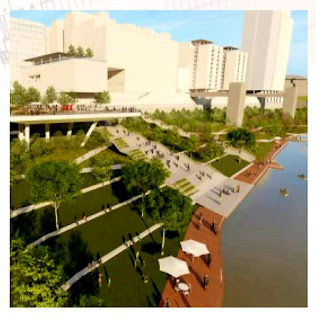But it's been five years since CWRU built a new dorm. That's due to change soon in the South Residential Village where Murray Hill and Adelbert roads intersect. There, two new dorms totaling 600 beds are due to see construction start next year and be completed in 2023, according to administrators and architects who made an on-campus presentation to students this week.
The construction will follow completion of renovations to the neighboring Fribley Hall and surrounding commons which are scheduled to start this year, said Christopher Panichi, director of planning, design and construction at CWRU, at Tuesday's presentation.
In June 2018, CWRU hired the Albert M. Higley Co. as its general contractor for the renovations to 1964-built Fribley Hall and commons, according to a notice of commencement filed by CWRU on Oct. 31, 2019. Higley's project commission expires Sept. 1, 2021, the notice shows. Fribley Hall was last renovated in 2000 but that was limited to the cafeteria.
South Residential Village expansion and total up to 185,000 square feet of new facilities, according to CWRU planning documents. These two new buildings will be for second-year students.
Plans for the new residence halls show one-bed rooms would measure 105 square feet and two bed rooms would measure 170 to 171 square feet. Furnishings are proposed to include one or two bed/dressers, wardrobes and desks per room. Students provided input on the layout, decorations and furnishings at Tuesday's meeting.
Between Fribley Hall and the new residence halls will be a new outdoor dining area and expanded Fribley Commons. A loading area for Fribley Hall will be demolished to make way for the expanded commons and to open up the north side of the hall with more glass.
A third phase proposed across the street could follow the construction of the first and second phases. Conceptual plans for the third phase show two connected residential buildings on CWRU parking lot No. 44 between Fribley Hall and the Greater Cleveland Regional Transit Authority's Cedar-University Red Line rail station that was renovated in 2014. There is no estimated cost yet for the third phase.
The land at the top of the hill could then be used for recreation or sold for redevelopment, according to the long-range plan. But given the university's growing enrollment, that plan may be delayed.
The architect for the new South Residential Village dorms is William Rawn Associates of Boston. The firm's portfolio has one local project -- Cleveland Clinic's Taussig Cancer Center, 10201 Carnegie Ave. No other housing expansions are planned by CWRU even though additional off-campus leasing of apartments is difficult to secure absent new inventory.
Construction of additional off-campus housing could happen soon with the start of Midwest Development Partners' four-block-large Circle Square development. Although technically the project began with the recent renovation of Fenway Hall at Euclid Avenue and East 105th Street.
Under an affiliate Library Lofts LLC, Midwest Development Partners purchased two parcels Jan. 2 from University Circle Inc. for $325,000, according to county records.
The MLK branch library would relocate from a neighboring parcel to avail that site for a future phase of the Center Square development. The old Third District Police Station on Chester Avenue was recently demolished for another, as yet unannounced phase of Circle Square.
Minutes from a recent meeting of the Cleveland Public Library's board of trustees noted that the library has received a letter of credit from Midwest Development Partners. It states that the developer is able to fund the entire Library Lofts project. Most of the funding for the apartments portion is from equity partners, according to the minutes.
 |
| Construction is nearly complete on 1609 Hazel Apartments that will add 110 apartments to the University Circle area for all interested renters, including CWRU students (CIM). |
That doesn't include residential buildings constructed by two other University Circle-area institutions -- the Cleveland Institute of Art (CIA) and Cleveland Institute of Music (CIM). CIA opened the 191-bed Euclid 117 Residence Hall in 2018 exclusively for CIA students.
And, CIM and NewBrook Partners are nearly finished building 1609 Hazel Apartments, which are due to open this year. Although instigated by CIM, anyone can rent one of the 110 apartments there, including CWRU students.
END







































